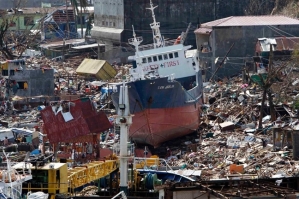
Typhoon Haiyan, one of the strongest storms ever recorded, ripped through central-eastern Philippines on Nov. 8, displacing more than 650,000 people. An estimate of at least 10,000 people are dead with thousands still unaccounted for. Officials have confirmed 1,600 dead as of Sunday evening.
The storm's 8 to 13-foot surge which is blamed for much of the destruction near the bay, particularly in Tacloban, where many neighborhoods in small villages were washed away. At the height of the storm, survivors recounted struggling in waist-high flooding on second floor homes, according to New York Times.
Many of the residential commercial buildings in eastern Philippine city of 220,000 were destroyed. In the wake, corpses lay along the roads lined with seriously damaged homes and toppled power lines, the Times reported. Haiyan was a Category 5 storm, with winds more powerful than those of Hurricane Katrina when it made landfall near New Orleans in 2005.
With the roads littered with debris, the roads has become unidentifiable. Persistent and heavy rain further complicated the disaster relief efforts. Survivors were in dire need of fresh drinking water, food and shelter. Hospitals were over-crowded.
The government has confirmed 1,563 deaths through Sunday evening in the hardest-hit region, and the death toll would "most likely" rise, according to Eduardo del Rosario, the executive director of the National Disaster Reduction and Management Council, according to New York Times.
One of the biggest question left unsolved is that many people who seem to have disappeared, possibly sucked out to sea when the ocean returned to its usual level.







